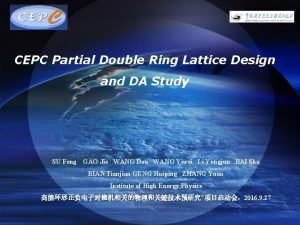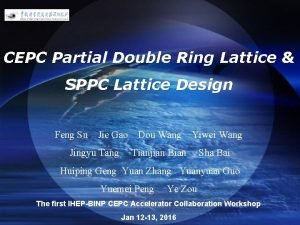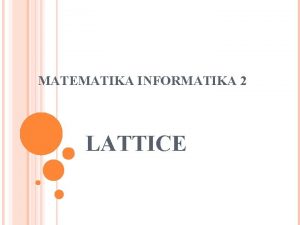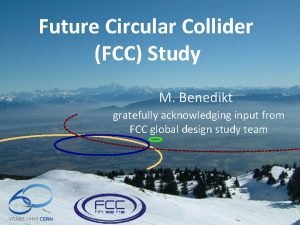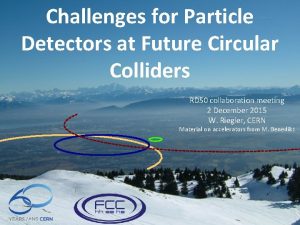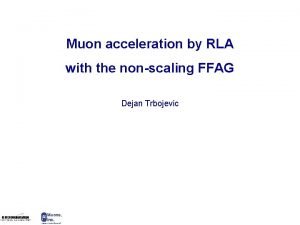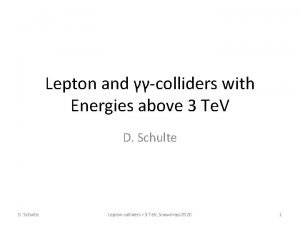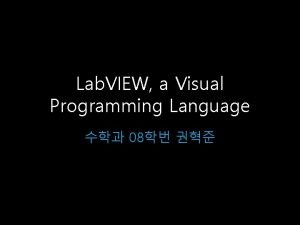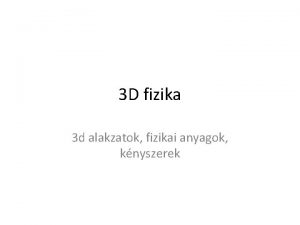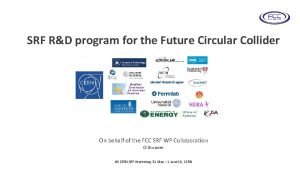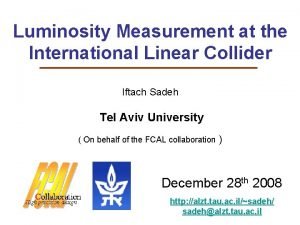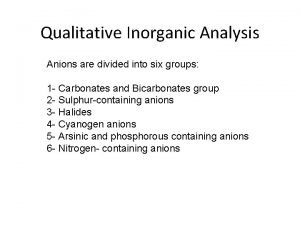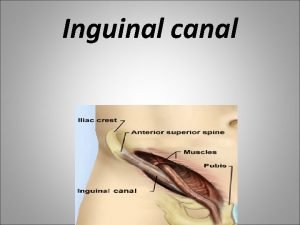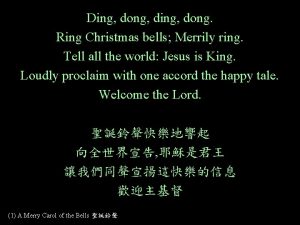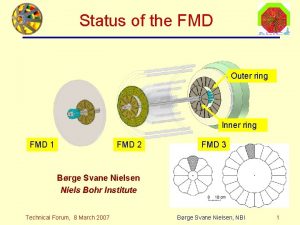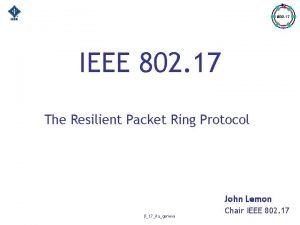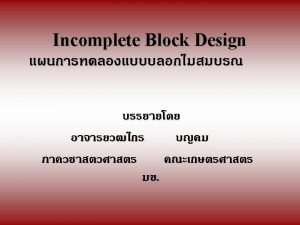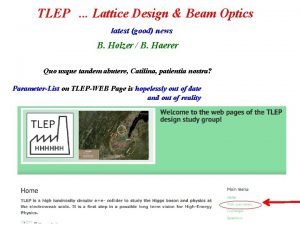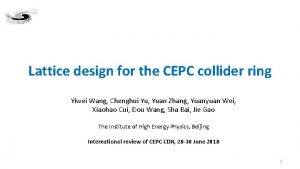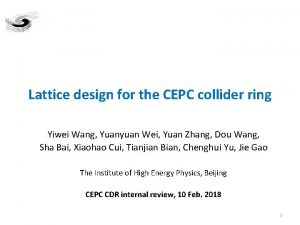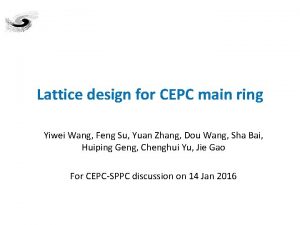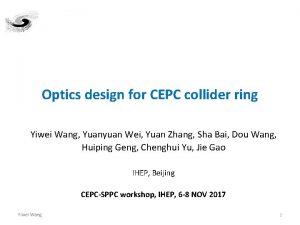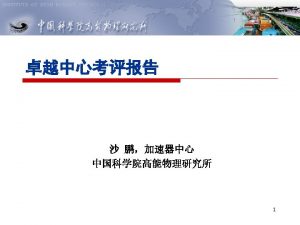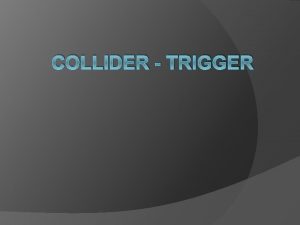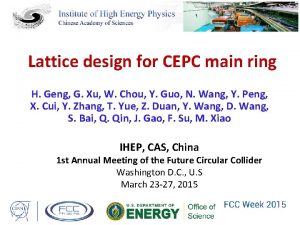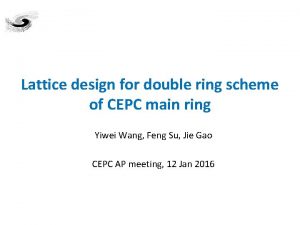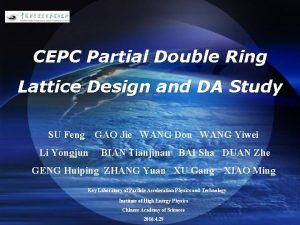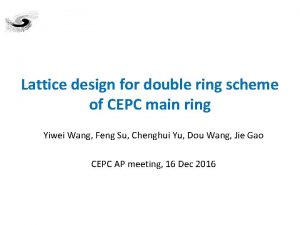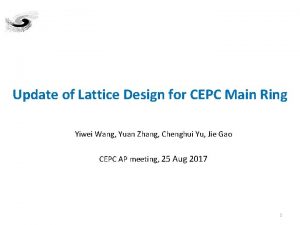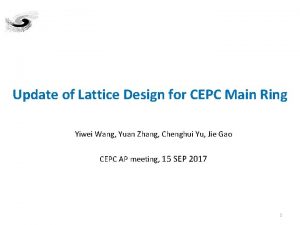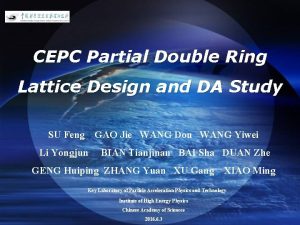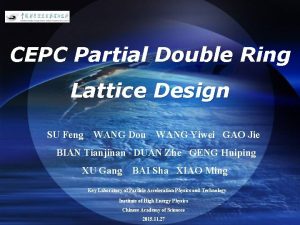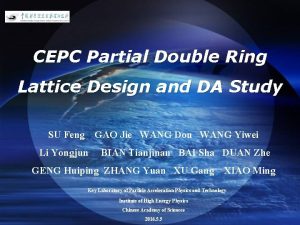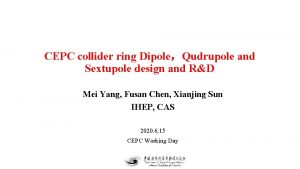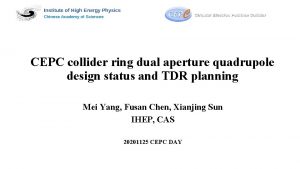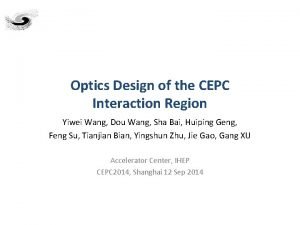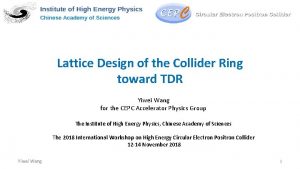Lattice design of the CEPC collider ring Yiwei










![Maximization of the bend filling factor in the ARC CDR lattice Emittance [nm] Period Maximization of the bend filling factor in the ARC CDR lattice Emittance [nm] Period](https://slidetodoc.com/presentation_image/2341b79f7b81c43629a63f75aaae4000/image-11.jpg)













- Slides: 24

Lattice design of the CEPC collider ring Yiwei Wang, Bin Wang, Jin Wu, Yuanyuan Wei, D. Wang, Yuan Zhang, Chenghui Yu, Jie Gao The Institute of High Energy Physics, Chinese Academy of Sciences CEPC MDI Workshop IHEP, CAS, 28 -29 May 2020 1

Outline • • Correction of magnet errors based on CDR lattice Lattice design for a higher luminosity Dynamic aperture optimization Summary 2

Correction of magnet errors based on CDR lattice (by*=1. 5 mm) Bin Wang, Yuanyuan Wei, Yiwei Wang 3

Correction scheme • Closed-orbit-distortion (COD) correction with sextupoles off • BPMs placed at quadrupoles (~1500, 4 per betatron wave) • Horizontal correctors placed beside focusing quadrupoles(~1500) • Vertical correctors placed beside defocusing quadrupoles(~1500) • Orbit correction is applied using orbit response matrix and SVD method. • Turn on the sextupoles and perform COD correction again • Dispersion correction with dispersion free steering • orbit manipulation by knob correctors • Beta beating correction with LOCO of Accelerator Toolbox • Coupling and vertical dispersion correction (Local coupling parameter correction) • Using the trim coils of the sextupoles (~1000), which providing skew-quadrupole field 4 4

The alignment requirement Case 1 Component Field error Arc quadrupole 100 100 Dipole 0. 01% IR Quadrupole 50 (30 for FF) Quadrupole 0. 02% Sextupole 100 100 Component Field error Case 2 Component Arc quadrupole 100 100 Dipole 0. 01% IR Quadrupole 50 50 50 Quadrupole 0. 02% Sextupole 100 100 Component Field error Case 3 Component Arc quadrupole 100 100 Dipole 0. 01% IR Quadrupole 100 100 Quadrupole 0. 02% Sextupole 100 100 Low converged rate of the betabeating correction (~20%). Further correction is undergoing. 5

Dynamic aperture with error and corrections Case 2: IR=50 mm, 226 seeds satisfy Case 3: IR=100 mm, 25 seeds satisfy

Lattice design for a higher luminosity 7

Higgs (CDR) Number of IPs 2 Beam energy (Ge. V) Circumference (km) 120 100 Synchrotron radiation loss/turn (Ge. V) 1. 73 Crossing angle at IP (mrad) 15. 0 242 (0. 68 s) 17. 4 30 10. 7 Momentum compact (10 -5) function at IP x* / y* (m) Emittance ex/ey (nm) 1. 11 0. 36/0. 0015 Beam size at IP x / y ( m) Beam-beam parameters x/ y RF voltage VRF (GV) RF frequency f RF (MHz) (harmonic) 1. 21/0. 0024 much larger natural chromaticity 20. 9/0. 06 2. 72 Bunch length z (mm) 4. 4 HOM power/cavity (2 cell) (kw) 0. 46 Energy spread (%) Energy acceptance requirement (%) Energy acceptance by RF (%) Photon number due to beamstrahlung 0. 134 1. 35 2. 06 Beamstruhlung lifetime /quantum lifetime* (min) single bunch charge increased thus larger momentum acceptance required 0. 018/0. 109 2. 17 650 (216816) Natural bunch length z (mm) F (hour glass) Luminosity/IP L (1034 cm-2 s-1) D. Wang et al 3. 48 (1010) Bunch number (bunch spacing) Beam current (m. A) Synchrotron radiation power /beam (MW) Bending radius (km) Lifetime (hour) The filling factor of bends should be increased to get a even lower SR with smaller emiitance. 16. 5× 2 Piwinski angle Number of particles/bunch Ne Way to a high luminosity Higgs lattice larger momentum acceptance required 0. 082 80/80 0. 43 0. 89 2. 93 8

Lattice design with higher luminosity • • Optimization of the quadrupole radiation effect – Interaction region: longer QD 0/QF 1 (2 m/1. 48 m => 3 m/2 m) – ARC region: longer quadrupoles (2 m => 3 m ) Reduction of dynamic aperture requirement from injection – Straight section region: larger x at injection point (600 m => 1800 m) Maximization of bend filling factor to minimize the synchrotron radiation loss per turn – ARC region: sextupoles in two rings changed from staggered to parallel; The left drifts are used for longer bend. – RF region: shorter phase tuning sections Stronger optimization and stricter hardware requirement should be made to get enough dynamic aperture 9

Optics design of Interaction region • • local chromaticity correction of both plane, asymmetric layout 1), crab-waist collision 2) L*=2. 2 m, C =33 mrad, GQD 0 =77 T/m, GQF 1 =63 T/m, LQD 0 =3. 0 m, LQF 1 =2. 0 m IP upstream of IR: Ec < 120 ke. V within 400 m, last bend Ec = 25. 5 ke. V (45 ke. V CDR) IP downstream of IR: Ec < 300 ke. V within 250 m, last bend Ec = 36. 6 ke. V (97 ke. V CDR) 1) K. Oide et al. , ICHEP 16. 2) M. Zobov et al. , Phys. Rev. Lett. 104, 174801(2010). 10
![Maximization of the bend filling factor in the ARC CDR lattice Emittance nm Period Maximization of the bend filling factor in the ARC CDR lattice Emittance [nm] Period](https://slidetodoc.com/presentation_image/2341b79f7b81c43629a63f75aaae4000/image-11.jpg)
Maximization of the bend filling factor in the ARC CDR lattice Emittance [nm] Period length [m] Drift length In one period [m] Dipole length In one period [m] Quadrupole length In one period [m] Sextupole length In one period [m] Dipole filling factor [%] Quadrupole filling factor [%] 1. 21 342. 9 31. 8 High lum. lattice 0. 89 312. 8 10. 2 286. 9 268. 4 20 30 4. 2 83. 7 5. 8 85. 8 9. 6 11

Optics of the whole collider ring 12

Dynamic aperture optimization 13

Optimization of final doublet design Add weak quadrupole coils Distance of Q 1 and Q 2 Radiation power y Chromaticity y length of Q 1 length of Q 2 This knob need to be check with DA result. 14

Optimization of final doublet design Different strength ratio of Q 1 B and Q 1 C with different length ratio of Q 1 B and Q 1 C when keep total length of Q 1 B+Q 1 C • • • Iqy 1≈Kb^2*βb*Lb+Kc^2*βc*Lc ≥ 2 Kb. Kc(βbβc. Lb. Lc)^1/2 when Kc/Kb=((βb/βc)/(Lc/Lb))^1/2 Minimum of radiation power occurs at KQ 1 C/KQ 1 B≈0. 6 Different length of Q 1 B and Q 1 C doesn’t affect much on the minimum of the power and chromaticity. • Provide more freedom of the FD technical design Shorter and stronger Q 1 B help a bit on the DA. 15

Optimization of final doublet design The vertical radiation power and chromaticity decreased significantly. These optimization will help to further decrease the by* Parameters Px [a. u. ] Py [a. u. ] Chromx [a. u. ] Chromy [a. u. ] <KQ 1 A> [T/m] KQ 1 C/KQ 1 B LD 2 [m] LQ 1 B+LQ 1 C [m] LQ 1 C/LQ 1 B LQ 2 [m] Before optimization 30 1209 -90 -3429 0 1 0. 23 3 1 2 After optimization 26 674 -118 -2909 40 0. 6 3. 5 1 2 with εx=0. 68 nm, cp=1%, σe=0. 134%, bx*=0. 33 m, by*=1 mm Contribution to Py 0. 56 0. 78 0. 92 0. 88 0. 87 - Contribution to Chromy 0. 85 0. 87 0. 94 1. 00 1. 04 16

Dynamic aperture vs. emittance • Larger normalized dynamic aperture with smaller emittance ( for ex~1 nm ) – The nonlinearity in interaction region is much larger than the arc region – Better DA with smaller emittance benefits from smaller nonlinearity in the IR and smaller beam size though stronger nonlinearity in ARC thus stronger error correction will need – Efficient direction of dynamic aperture optimization – Just show the tendency; each dynamic aperture result can be further optimized with directly optimization DA without fluctuation 17

Optimization of dynamic aperture • • Start point of the optimization – Nonlinearity optimized term by term with 10 families of sextupoles in the IR and 4 families of sextupoles in the ARC. Dynamic aperture further optimized with MODE – Higgs dynamic aperture with 90% survival of 100 samples – Including radiation damping, fluctuation, energy sawtooth and tapering, beam-beam effects, w/o error – 145 turns (2 damping times), 4 initial phases 18

Different versions of lattice • 19

Status of DA optimization • • Jin Wu, Yuan Zhang, Yiwei Wang 145 turns tracked, 100 samples for radiation fluctuation, IR sextupoles + 32 arc sextupoles With beam-beam and SR radiation damping and fluctuation, without errors The on-momentum DA should be large enough even with errors. The momentum acceptance need to be further optimized to fulfill the requirement ~1. 7 %

Analytic formula for dynamic aperture • Jie Gao and Ming Xiao’s analytic formula for DA On momentum Off momentum 21

Comparison of analytic and simulation result • The analytic and simulation results of dynamic aperture agree well for small energy deviation particles. – Jie Gao and Ming Xiao’s analytic formula for DA are used. – BEPC II lattice: agree well with tracking – CEPC lattice: agree well with tracking if mainly 3 rd resonance exsit • Including more aberration in the DA formula is under going analytic simulation BEPCII, w/o synchrotron motion analytic simulation CEPC, w/ mainly 3 rd resonance, w/o synchrotron motion 22

New separation scheme with kicker and septum Use kicker to instead of electro -static separator in order to reduce the impedance. (Proposed by Jinhui Chen) Integrated strength BL [T*m] Kicker 0. 1624 Strength B [Guass] 203 Effective length Leff [m] 8 Half width of good field region 10. 1/3. 8 Hgf/Vgf [mm] @ 5 E-4 Half width of beam stay clear 9. 6/3. 6 Hbsc/Vbsc [mm] Septum width [mm] - Septum 1. 4 1000 14 18. 9/3. 8 @ 5 E-4 9. 2/3. 6 5 Field for up to 182. 5 Ge. V. Septum is weak to suppress emittance growth. Kicker: 18σx+3 mm+d 1/2, 18σy+3 mm Septum: 18σx+3 mm+d 2 e/2, 18σy+3 mm 18σx+3 mm, 18σy+3 mm 23

Summary • • • Lattices for a higher luminosity has been designed whose by*=1 mm, ex=0. 68 to 0. 89 nm rad Stronger optimization had be made in order to get enough dynamic aperture. Dynamic aperture optimization – The on-momentum DA should be large enough even with errors. – The further optimization of momentum acceptance is under going to achieve 1. 7%. – Some new attempts made for further optimization of dynamic aperture including final doublet optimization, decreasing emittance and application of analytic DA formula. • With by*=1. 5 mm lattice, error correction made with 1000 random seeds and the prealignment requirements has been loosed, especially for the IR quadrupoles. 24
 Cepc logo
Cepc logo Cepc logo
Cepc logo L a t t i c e
L a t t i c e Fcc collider
Fcc collider Fcc collider
Fcc collider Bnl
Bnl Muon collider
Muon collider Language
Language Unity sphere collider
Unity sphere collider Hadron collider
Hadron collider Hadron collider
Hadron collider Fcc-ee
Fcc-ee International linear collider
International linear collider Anions
Anions Strong no in c
Strong no in c What is hesselbach's triangle
What is hesselbach's triangle Deep ring inguinal canal
Deep ring inguinal canal Ding dong, ding dong christmas bells are ringing
Ding dong, ding dong christmas bells are ringing Wise men gifts
Wise men gifts Inner ring and outer ring
Inner ring and outer ring Resilient packet ring
Resilient packet ring Steel truss design example
Steel truss design example Balanced lattice design
Balanced lattice design Lattice beam design
Lattice beam design Major connector function
Major connector function
